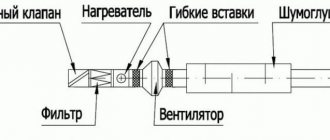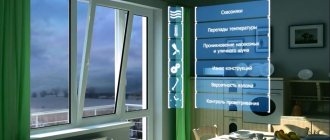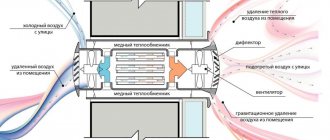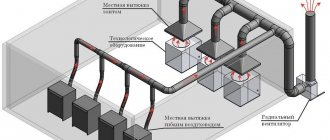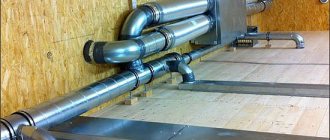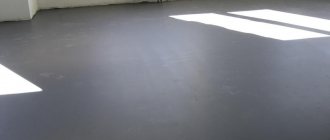The problem of insufficient air exchange in a room is easy to recognize - foggy windows, characteristic odors, stuffiness. Poor ventilation in an apartment results in rotting of wallpaper, furniture and other household items. The result of the lack of regulation in the flows is a lack of fresh air and dust.
When designing a ventilation system in a multi-storey building, emphasis is placed on natural circulation. The outlets from each apartment are connected in a shaft and remove stale air to the street. The supply ensures ventilation of the room. Lack of inflow, channel blockage, natural disasters do not allow natural ventilation to cope with the task, especially if plastic windows are installed in the living space.
Ventilation system in the apartment
The need for high-quality air exchange in a living space is determined by the following factors:
- constant replacement of used air flow with fresh is necessary for human health and well-being (lack of oxygen directly affects the efficiency of brain activity, the functioning of the nervous and immune systems, and muscle activity);
- throughout his life, a person releases heat, moisture, carbon dioxide into the surrounding space, which must be removed from the room;
- High air humidity promotes the formation of mold on the walls of the bathroom and kitchen, which negatively affects human health (black mold is especially dangerous) and damages the interior space and furniture.
The ventilation system in the apartment can be organized naturally or forced. Moreover, each of them is easy to install independently (separately or combined). Next, we’ll look at how to make ventilation in an apartment with your own hands.
What does the lack of normal ventilation lead to?
Due to increased humidity, mold may form on the walls.
The supply and exhaust system is considered normal if it provides the standard standards for humidity and air purity in the room specified in SNiPs. This directly depends on its performance and the correct location of the supply valves. Unsuccessful ventilation arrangement or lack of ventilation capacity can lead to the following consequences:
- Increased humidity in the room. The walls become damp, streaks form on the glass, and water accumulates on the window sills.
- Blackening in the corners. Moisture promotes the formation of colonies of fungi that settle in shaded areas.
- Deterioration in health. In a poorly ventilated building, pathogenic bacteria actively accumulate. In addition, fungi release microscopic spores, which cause allergic reactions and complications to the respiratory organs.
- Damage to furniture and interior elements. Dampness promotes peeling of parts of wood boards and swelling of coatings.
- Excessive dryness in the room. The problem occurs when there is no ventilation and the radiators are very overheated. It’s hard to breathe in your home and the furniture is drying out.
Dry air is poorly tolerated by indoor plants; additional humidifiers are required.
Signs of disturbance of natural air exchange
- odors after cooking do not disappear for a long time;
- Condensation collects on the windows;
- mold appears on the walls of the bathroom, toilet, and on the window opening;
- the bathroom remains constantly damp;
- there is musty air inside the bathroom;
- condensation also collects on the bathroom walls after using hot water for a long time;
- the wet suspension from the bathtub does not last long;
- wet clothes take longer to dry than usual;
- The air inside the rooms is constantly stuffy.
Conclusions and useful video on the topic
The lack of natural ventilation can be compensated by installing forced-air equipment. When drawing up a ventilation project, turns, transitions, and narrowings should be minimized. These elements negatively affect aerodynamics, increase noise, and accumulate grease and dust.
Installing an additional ventilation system leads to financial costs. The services of specialists are more expensive than independent installation. The final cost depends on: the number of square meters, the purpose of the room, the number of residents, and the dimensions of the window opening.
In a private building, ventilation can be done according to preference. In multi-storey buildings you need to adjust the system to suit you. Excess draft is eliminated with the help of adjustable ventilation grilles, and the deficiency is compensated by installing additional fans. Information about proper installation can be gleaned from the video.
Natural ventilation
The essence of natural ventilation is the independent influx and then removal of air masses from the room. It is produced due to the difference in temperature between fresh cold and exhaust warm air flows.
Apartment buildings are equipped with ventilation shafts designed to remove old air from the premises to the outside. They start from the bathroom and kitchen with entrances closed with decorative grilles. The outlets of the ventilation ducts are located on the roof of the buildings. Separate air ducts are provided for each apartment.
Air circulation with natural ventilation
The natural circulation of air flows occurs as follows. The heavy cool flow from outside enters the rooms through an open window/vent, thereby pushing the light and warm flow out of the house through the ventilation shaft. This is how the flow of air masses inside the apartment should occur.
How to make ventilation in the garage with your own hands? >>>>
Attic and basement ventilation without dormer windows
When building a private house, the issue of ventilation is very important. The less heat loss from open windows, the less energy required for heating. When adding piping to the project to supply air to all rooms, we must not forget about the space under the roof and the basement. Ventilation windows are needed in the attic, even if it is cold and well insulated. It will not allow the rafters to rot, the insulation to become damp and mold to appear.
Free space in the basement or attic can be used to install recovery and air exchange systems and lay pipes throughout the house. Fence grilles can be installed on the gables. Then the ventilation of the attic or basement will take place without dormer windows.
Attic ventilation
Features of natural ventilation of modern housing
In practice, natural air exchange inside modern urban housing is ineffective for the following reasons:
- old exhaust shafts are clogged with accumulated dust and debris, which significantly impairs the outflow of exhaust air flow from the rooms;
- the rules for installing kitchen exhaust systems at neighbors were violated, which interferes with the removal of stale air;
- modern plastic windows and metal doors reliably protect the interior space of residential premises not only from heat loss, but also from the natural flow of fresh air.
The tightness of plastic windows and metal doors changes the flow pattern of air masses inside the apartment space, creating a new balance of air flows with negative pressure. A ventilation shaft with greater air conductivity (usually a kitchen) overturns the draft of a smaller bathroom shaft. This leads to the penetration of cold air mass from there in winter. It is especially noticeable in windy weather, when the draft increases under the influence of the wind and a cool flow penetrates into the bathroom.
In addition, foreign odors often do not enter through the ventilation shaft. They penetrate through leaks in places where gas/heating pipes are installed.
Supply valves
Supply (or ventilation) valves are divided into window and wall valves. Ventilation supply valves on plastic windows can be easily installed independently in 15 minutes; Installing a wall valve is a little more difficult because you have to make a hole in the wall.
These devices have many advantages:
- It is possible to regulate the air flow (manually or automatically).
- The windows stop fogging up.
- The valve is inexpensive - from 600 rubles.
- The device is quite easy to install and maintain.
Unfortunately, there are also a lot of disadvantages:
- Window ventilation valves are equipped with a maximum of one filter – coarse filter. That is, all harmful gases, particles and fine dust will remain in the room.
- The performance of the device is not very high. The fresh air entering through the valve is usually only enough for one person.
- In winter, the valves on the windows for ventilation often freeze and stop working.
By the way, there is also a valve handle
. This window ventilator is installed in the window profile instead of a conventional handle. It works in the same way as other valves, but is less common.
Forced ventilation in an apartment with plastic windows
To improve air exchange, a forced ventilation system is provided in the apartment. It comes in three types:
- supply (an additional influx of air masses is provided. Due to the temperature difference, the stale warm flow is forced out through the ventilation ducts);
- exhaust (promotes better outflow of exhaust air flow);
- combined (mechanical supply and exhaust devices enhance air convection of the spatial environment).
These systems can be installed independently. Before installing forced (mechanical) air exchange devices, you must make sure that the ventilation ducts are working properly. If necessary, clean the air ducts coming from the apartment. The cleaning of the general ventilation riser is carried out by housing and communal services.
A forced ventilation system in an apartment begins with the installation of air supply devices. Under certain conditions this may be quite sufficient.
Stage two: cleaning
We check each vent individually. There is a difference in the deviation of the paper - blockage in the boxes indoors. This is not the worst case: we place the dish brush on a thin flexible steel cable (better) or on an aluminum wire (as a last resort), and screw as far as possible along the way. We remove the remaining debris with a vacuum cleaner with a long tube - a piece of vinyl watering hose works well. It is quite rigid and at the same time flexible.
Did not help? Did you find any garbage? This means that the main ventilation duct is clogged. We clean it the same way, but you need a larger brush. Most likely, you will also need a rod, wooden or metal, or a piece of fiberglass rod, which cable workers use, with a hook.
Warning 2: Be careful when cleaning the main vents! There may be a nest of wasps or a crowd of other dangerous creatures.
standard ventilation scheme in an apartment building
If you live in an apartment building, cleaning the ventilation is the responsibility of the homeowner or the organization entrusted with the operation of the buildings, and you are not allowed to go into the main passage. In this case, you need to make a claim and submit an application.
Supply ventilation in the apartment
Forced supply ventilation is provided using simple devices that can be installed independently. This will organize or increase air flow. Under its pressure, the waste heat will rise higher and exit through the ventilation ducts.
Scheme of supply ventilation in the apartment
Advantages of fresh air ventilation:
- ensuring constant high-quality air exchange;
- fresh air is filled without an open window/vent;
- minimum cost;
- saving heat when the cold season comes;
- the ability to regulate the strength of the air flow;
- filtering of incoming street air is possible;
- simple installation that you can do yourself;
- ease of operation and further maintenance.
Which air ventilation option should I choose?
Regular ventilation by opening PVC windows has both advantages and disadvantages. In the list of the first, one can highlight, for the most part, only accessibility - opening the sash at the right time is not difficult. But we should not forget about the disadvantages:
- During the cold season, the temperature inside the room will also decrease;
- A draft that occurs during ventilation is the cause of colds;
- Along with fresh air currents, pollution, allergens, and extraneous sounds will begin to rush into the room;
- In the autumn-winter period, condensation will form.
These disadvantages can be avoided by taking care of organizing forced or combined (supply + specialized window) ventilation. Contact managers right now - online or by phone.
Our specialists will help you decide on the appropriate ventilation equipment option - choose a budget ventilation valve or a multifunctional modern hood. The purchase of any product is possible on a turnkey basis - with delivery, installation and commissioning. Pay special attention to breathers and recuperators.
Note:
Both the ventilation products themselves and the high quality of their installation are provided with official guarantees.
How to make fresh air ventilation in an apartment with your own hands. Scheme
It’s easy to create fresh air ventilation in a living space (for more information about supply and exhaust ventilation, see here).
1. The easiest way to independently organize a source of fresh air is to reduce the tightness of plastic windows .
Necessary:
- open the window sash, on which the seal is located along the contour;
- On the bottom of the sash, carefully cut and remove a small piece of seal (no more than 50 mm);
- Carry out the same manipulations on the upper part of the sash;
- close the window sash.
Through the resulting hole in the seal, air from outside will penetrate into the space between the frame and the window frame. Gradually heating up, it will rise and exit through the upper hole of the sash seal.
2.Window ventilator
Installation:
- cut a hole of a given size on the upper inner part of the plastic double-glazed window;
- insert the inner part of the supply valve there;
- make a hole at the bottom of the window outside;
- insert a visor there to protect against moisture.
When the supply air gets inside the lower valve, as it warms up in the space between the windows, it will rise up and exit through the second hole of the ventilator.
Disadvantages of the device:
- cool air;
- there is no way to control the incoming air flow;
- the air comes in unpurified.
3.Wall ventilator
This is a plastic pipe with heat and sound insulation. A grate is installed on the street side. An air purification filter and an air flow regulation valve are installed on the apartment side.
Valve design KIV-125
Installation:
- make a through hole inside the wall of a certain diameter (recommended between the heating radiator and the window to warm the incoming air in winter);
- insert a plastic pipe with insulating material there so that the outer outlet is flush with the wall, and the inner one protrudes slightly above the plane of the wall;
- drill holes for fasteners;
- install a filter;
- close the entrance from the outside with a special grille;
- secure the housing with the flow control valve inside.
Supply ventilation of the apartment
Installation of duct air exchange systems
The popular shape among air ducts is square, and among fans it is round, so it is important to make the connection correctly:
- Find the optimal method.
- Place the device in the air duct. Correctness will be reflected in the flow intensity and noise level. The schematic representation assumes the use of an equivalent diameter:
D=√4hb/π,
where h is height;
b – width of the air outlet.
- Select the direction of the fan motor that ensures proper air flow.
- It is necessary to install the fan with the least number of turns. A large number of bends leads to flow inhibition and reduced productivity.
Installation of a round duct fan requires the following procedure:
- Unscrew the cover located on the terminal box.
- Connect the wires to the appropriate terminals.
- Close the lid, check the connection, plug the device into a power outlet.
- Use split clamps for installation in the air duct.
- Arrange the mounting brackets compactly.
A flat surface is suitable for fixing the fan. The channel device requires flange connections with an adapter (relevant for square and rectangular sections). Equipment and accessories must comply with SNiP 3.05.01-85.
The manufacturing material must be resistant to temperature and aggressive influences. Before purchasing a fan, you need to calculate the power. The performance value varies depending on the length of the air duct, installation location and fan cross-section.
Basic rules for duct design
Additional ventilation is a project that involves the installation of cooling equipment. The scope of work depends on the characteristics of the premises and the client’s wishes. A split system is a separate turnkey structure that independently organizes the exchange of air flows, without ventilation.
The central system must be conceived and installed at the stage of laying the building shell. The developer must ensure that each living space has the ability to regulate the air environment.
The order of arrangement of ventilation draft in a private building is influenced by the types of materials used in the construction of the duct. The use of smooth boards or logs in conjunction with stove heating eliminates the need for additional circulation. The use of frame material or brick requires starting the design with determining the air exchange and the optimal cross-section of the channel.
The kitchen and sanitary rooms are rooms that are characterized by temperature and humidity, so they need to increase the air exchange rate. When drawing up a project, you must follow certain rules:
- analyze the room;
- calculate the main indicators - channel cross-section, efficiency, air exchange rate;
- choose a suitable design that is easy to access and maintain;
- isolate ventilation from noise and cold;
- select a device that matches the preliminary calculations.
A metal box is relevant for industrial enterprises that provide air outlet at high speed or work at negative values. For an apartment - a plastic structure - easy to install and easily fits into the interior.
Features of installation of plastic boxes
Section, color, method of connecting sections, shape, method of fastening - all these are distinctive features of plastic air ducts. Various shaped elements provide the ability to create ventilation ducts of any geometry. The selection of section is based on a maximum speed of 2 m/s. Ignoring the condition will lead to noise and increased resistance. The result is rapid wear of the system. The small mass of plastic parts does not require the purchase of serious fasteners.
The order of installation work depends on the location of the structure:
- Elements running inside the cabinet can be fixed to the walls using clamps.
- The passage through a wall or partition must be lined with insulating material to prevent rattling during operation of the device.
- Holders and screws are suitable for mounting above cabinets.
The distance between fasteners is 1 m. The ventilation duct running along a concrete slab, which will subsequently be covered by a suspended or suspended ceiling, must be checked under maximum load. The test may reveal problems and deficiencies that can be more easily addressed before access is closed. You can increase the density of connections using silicone sealant.
You should not use glue or “liquid nails”, otherwise it will be impossible to dismantle the structure for repair, maintenance or reshaping. Self-adhesive tape is suitable for quickly replenishing broken seals.
Do-it-yourself exhaust ventilation device in an apartment
A sufficient influx of fresh air and at the same time a small removal of exhaust air indicates that the natural exhaust ventilation in the apartment is weak. It is recommended to strengthen it yourself. To do this, fans are installed instead of ventilation duct grilles in the kitchen and bathroom.
Exhaust fan
Fans enhance the removal of stale air through the ventilation shaft, providing full air convection of the internal living space. It must be taken into account that a mechanical hood is installed only if there is a good supply. Otherwise, the bathroom and kitchen fans will alternately reverse the draft of the ventilation ducts, pumping stale exhaust air from the shaft. A random flow of stale air into the room is formed. When the fans operate simultaneously, there is no supply flow, so odors may come from neighboring apartments.
When organizing supply and exhaust ventilation, especially in an apartment with your own hands, you can use fans with humidity level sensors, preset timers, and a check valve to prevent air from flowing from the ventilation duct back into the living space.
What can be done in such cases?
No, you don’t need to replace good plastic windows with old wooden ones. In addition, no one suggests you open them wide during the cold season and let your apartment cool down.
Today there are windows with micro-ventilation that provide good air exchange. Such windows allow you to maintain a regular flow of fresh air into the apartment, thereby regulating temperature and humidity, will not create drafts, and will ensure the creation of a comfortable microclimate in your home.
Our task is to introduce you to each method in more detail so that you can independently choose the option that suits you best. Read about the consequences of poor ventilation and other ways to ventilate a room on the next page of our resource.
Combined air exchange method
Combines the two methods described above to improve air exchange in urban housing. It is organized using mechanical devices - fans. In this case, the volume of diverted air masses must be equal to the volume of inflow air.
Fans are installed inside air duct openings and ventilators. The most commonly used are axial, duct, and centrifugal fans. The price and model range is wide, it’s easy to choose the best option. Installation is simple and does not take much time.
How to organize
There is one universal rule in solving the problem of ventilation in a room without windows. Rooms with heavily polluted air must be equipped with an exhaust device. These include: bathrooms, kitchens.
For potentially clean rooms, it is sufficient to ensure good air flow through ventilation grilles or small gaps under internal doors.
The first thing that can bring air into a windowless room is a small gap under the door. Special overflow grilles built into the door are another option.
They can also be installed at the bottom of the wall. If there is insufficient air exchange, you can also use exhaust fans.
In the dressing room
Cabinets are usually installed in small rooms without windows. In this case, you cannot count on air flow through the gaps:
- the gap between the bottom edge of the door and the floor;
- special design of cabinet doors (with slots or plug-in ventilation grilles);
- holes in the walls that are located no further than 20-30 cm from the floor (you can go down, just above the baseboard);
- technological gaps arising from the construction of partitions;
- in private houses - through a ventilation hole in the floor (from the lower floor or from the basement, if there is normal humidity).
The dimensions of the air intakes depend on the cubic capacity of the room and the speed of the air masses. Standards for storage cabinets require one air change. For example, if your closet measures 1.5*2.0*2.8 (width, length, height), then its volume (obtained by multiplying all numbers) is 8.4 cubic meters. Within one hour, 8.4 cubic meters of air must be “pumped” to maintain a normal atmosphere. Thus, ventilation of the dressing room will prevent the formation of foreign odors.
With proper ventilation of the apartment, an air intake of 100*100 mm is sufficient for this. The cross section - round, square, rectangular - does not matter. The main thing is that its area remains the same or larger. And, as a rule, this parameter is calculated or found in accordance with the table. However, the tables show much larger volumes.
But closet ventilation will work well as long as there is an exhaust duct. It could be a similar grate in the wall. It should be placed on the wall opposite the air intake, closer to the ceiling. You should aim to keep these holes as far apart as possible so that the air flow covers as much of an area as possible.
If the air intake is made in the door, and the door is located in the middle of the width of the room, then it is worth installing two exhaust grilles - on the right and on the left, at a distance of 15-25 cm from the corners.
Where should the vents be placed? At best, to the ventilation duct. A possible option is outside, if one or more wardrobe walls face the outside. In this case, the air supply can be vented outside and the exhaust into the ventilation system or into adjacent rooms.
Closet
A common option both in an apartment and in a house is instead of installing regular wardrobes and/or chests of drawers.
The location of the air exchange depends on the number of walls (partitions) in the cabinet and the size of the cabinet. Typically, such cabinets are not huge: most of them are “simple” cabinets with shelves and drawers, simply not free-standing, but “attached” to the wall.
Let's consider how it can be ventilated in accordance with various schemes:
- If there is only one partition in the closet - the front one, and on the other 3 sides there are walls of the apartment bordering the living rooms. Simply cut inlet holes at the bottom and top of the baffle.
- If the wardrobe has only a partition, then on the other 3 sides there are living walls, one of which borders the bathroom/kitchen. In this case, a perimeter grille can be cut in the lower partition (through which air from the room will be sucked into the cabinet). To remove air, you can drill a hole in the wall between the cabinet and the kitchen/bathroom and cover it with a grill. This option is not the most convenient: in the future, you may want to change the layout and move the cabinet, but the hole in the wall will remain in the same place.
- If the cabinet has 2 or more compartments. In this case, a bypass grille is cut into the partition located closer to the window from below. The second bypass grille is cut from above (closer to the ceiling) in the partition, which is closer to the door.
Generally speaking, venting in cabinets is not necessary—in most cases, simply cutting overflow holes in the doors will do the trick.
Separate room with window
The simplest option is to do nothing: all conditions have already been met.
In this case, air flow can be ensured in the following ways:
- Leave the window cracked. Suitable if the window sash can be fixed in several positions and if there is no source of loud noises or odors under the window.
- Install the window comb and keep the window tilted. Suitable when the window sash does not have its own methods of fastening. As for the cost: the simplest comb can cost up to 1000 rubles.
- Install windows in micro ventilation mode (if the apartment is under renovation, or it’s time to replace the windows). This option is so much better than the previous ones that the window does not need to be opened all the time. This means that sounds and smells from the street, insects, rain or snow will not penetrate it.
- Install the window valve. Suitable in cases where it is impossible to leave the window open (for example, due to noise) and there is no ventilation mode. The disadvantage is that not everyone can install the valve themselves. The product itself will cost about 3-5 thousand (depending on the model), installation by professionals can cost about the same.
- Install a window fan. If you have a large closet or will store expensive items in it, then this option is worth considering. Natural ventilation (all of the above methods indicate it) has an unstable power, while a fan can maintain constant air exchange.
There should be a break under the cabinet door to allow air to flow in and out of the cabinet. If this is not possible, a bypass grille (or valve, for example Domvent) can be installed in the door leaf.
A more expensive and somewhat unknown option: you can install a miniature Aeromat unit in the window. Inside the rectangular housing there are fans that supply both supply and exhaust air. This means that they can freshen the air even in a sealed room. The disadvantage is that such products cost tens of thousands of rubles, and only a specialist can install them.
Separate room without window, street through the wall
Organizing a ventilation system in such a room will itself be more difficult than if the room had a window. However, there are many possibilities for implementation.
An example of a ventilation system for this layout: 1 – air intake through the gap under the door; 2 – connection point for the exhaust fan
In the previous paragraph, we looked at a scheme in which air enters the dressing room only from the outside - after all, in a room with a window this is the simplest option. If you don't have a window, you'll still need to make a hole in the wall for ventilation. Can be used for both inputs and outputs.
First let's look at how air is supplied through the wall. To do this, drill a hole in it and insert a wall valve. This option is the simplest and cheapest (the valve itself can be bought for 3-5 thousand, installation will cost the same).
There is another option, but it is not feasible: a power supply is placed instead of the valve. This device is more expensive: such equipment will cost more than 10 thousand rubles. The main thing: the units have a large air capacity - which is not needed for a small room, for example, a dressing room.
As mentioned above, you can arrange for the exhaust pipe to be removed from the cabinet rather than brought in from it. In this case, drill a hole in the wall and insert an exhaust fan (which will not blow into the room, but from outside). This is a good solution if the dressing room is located far from the kitchen/toilet.
The general rule for both methods is that there must be airflow between the closet and the hallway (or room). This requires either a gap under the door or a bypass grille in the door leaf.
Separate room, surrounded by other rooms
The most inconvenient and difficult option to implement. Such layouts are common: owners often create their dressing rooms in closets that are located “inside” the apartments. Additionally, when houses are built with walk-in closets, they are typically built to this type of plan.
In this case, it will be more difficult to complete the task, especially on your own (without specialists). There are several solution schemes:
- A hole is made in the wall bordering the living room with a window - if the room is further from the kitchen/bathroom than the dressing room - and covered with bars. Air will pass through it. The air is exhausted through the gap under the door into the hallway and then into the nearest ventilation pipe or eaves. If there is no gap, a bypass grille is installed in the door.
- If there is a kitchen or bathroom opposite a closet or room with a hood, a hole is made in this wall and covered with a grill. The air will be exhaled through this hole. Fresh air will enter through the gap under the door grille/overflow grille.
- If the house/apartment is undergoing renovation and suspended ceilings are installed, you can organize a system of air ducts through which air will be taken from each room. In this case, a separate line is drawn to the cabinet. The influx of fresh air will pass through the gap under the door. The exhaust duct can go either to the nearest hood (as in the photo above), or through the wall to the outside (in this case, an exhaust fan is placed in the duct).
Kitchen
It is important that the ventilation system is equipped with a ventilation duct. This will act as an exhaust system and the used air will be removed through it. Another option is to exhaust air through a kitchen hood (which can be directed into a ventilation shaft or directly outside through a wall or duct).
Air will come from other rooms either through the cracks under the door or through the overflow grilles (if there are no cracks).
In this case, it is necessary to check the draft of the ventilation shaft. To do this, take a strip of thin paper and apply it to the ventilation grill.
If the paper is attracted, the air roller is working properly. If it doesn't work or has very little pull, it means the air roller is either not working at all or not working well (it may be clogged and needs to be cleaned). If for some reason cleaning is impossible now, it makes sense to install an exhaust fan in the wall with access directly to the street.
The fan's performance must be capable of completely extracting an amount of air equal to the number of people living in the apartment, multiplied by 30. For example, if 3 people live in an apartment, then the fan must exhaust at least 90 cubic meters of air per hour.
Ventilation in a blind bedroom without a window
If there were no windows when the bedroom was built, there is one reliable way to ensure proper air exchange.
For this purpose, a mandatory type system will be installed, which will consist of:
- several fans;
- air heating device;
- supply air filters;
- ventilation grates;
- air channels.
Installing a ventilation system in a bedroom without a window is done by creating several holes in opposite walls where the above equipment is installed.
The completed system must pass incoming air through filters, heat it, and release it through vents.
In a room that borders the street
There is an effective option, which is possible if the room bordering the street through the wall is not dirty (kitchen or bathroom).
In this case, it is recommended to create an air flow in one of three ways:
- using a power supply;
- use of wall dampers for air supply;
- from a fan installed in the fan.
To ventilate the air, it is necessary to create an inlet inside the living space through grates in the wall or doorway so that air can freely flow into the room in which the hood is installed.
If the room borders the street through at least one wall, then a specially designed hole with a fan is sufficient for normal air exchange.
In this case, air is removed outside while air is brought in from other rooms.
In a room that does not border the street
The first option is to lay a separate ventilation duct. This is possible if the building has at least one air exchange system that supplies or extracts air masses.
In addition to the existing system, a ventilation system must be installed (if there is an input, sort the output and vice versa).
If the room is located between the supply room and a room equipped with an exhaust hood, then the air flow will pass through several openings with special grilles (which can be supplemented with fans).
This option is suitable in cases where intensive air exchange is not required. Usually the rooms are small in size. A necessary condition is the filtration of incoming air.
In large rooms or rooms that are very far from the ventilation shaft, it is necessary to install separate air ducts to provide supply and exhaust air for the exhaust. In this case, a fan must be installed for each of them.
Do-it-yourself forced ventilation in the apartment. Advantages
- air exchange improves;
- microclimatic indicators of the internal environment are normalized;
- the humidity level is equalized;
- condensation does not accumulate on the walls;
- dampness stops accumulating inside the bathroom;
- prevents the appearance of mold, pathogenic bacteria, microorganisms whose breeding ground is a warm, humid environment;
- stale odors are quickly removed through the ventilation ducts.
The organization of forced supply, exhaust or combined convection can be done with your own hands. It is quite simple, does not require large financial expenditures, and is quite effective. In this case, the result of the invested efforts will pay off in the very first time the mechanical system operates.
Stage four: creating air flow
The natural system of air flow into living spaces is vents, cracks and cracks in doors and windows. But in the winter, for the sake of warmth, they try to seal them up, and keep the windows closed. Modern doors and windows close so tightly that in such an apartment you can fly into space. Therefore, air flow during the cold season has to be ensured by additional measures.
Old windows
If you have old-style windows with wooden frames, do not seal them up for the winter. Insulate with adhesive-backed foam strips; they are commercially available for this purpose. When purchasing, you need to make sure that the foam rubber is sufficiently loose and breathable.
Wait, why do this in winter? We need to seal it up more tightly! More densely, but with intelligence and knowledge of physics. Wind, or temperature differences, push air through the foam into the house. In small tortuous pores, the so-called. throttle effect. Simply, the air heats up from friction against itself. And the fierce wind that used to chill the house can now even heat it. The stronger the rage, the stronger the throttling effect.
Previously, when there was no foam rubber, cotton wool rolls were placed between the frames for this purpose. Small figures were also placed on them: snowmen, Christmas trees, Father Frost and the Snow Maiden, etc. Some craftsmen created such compositions that passers-by stood for a long time in front of their windows.
Double-glazed windows
Modern PVC windows do not need to be specially insulated; they already close very tightly. In most models, except for the very cheap ones, which even the offshore Chinese shy away from, instead of a vent, adjustable air intake slots are provided (see the figure on the right). The location of such a gap at the top is physically correct. This system operates in cold weather, the air from the gap goes down, mixes with warm air from the battery, and the temperature in the room is equalized.
PVC windows with inflow are designed for use together with modern aluminum heating radiators. When they work in pairs, there is most likely no need for any additional air flow into the living rooms.
Supply valves
In public spaces, where there are a lot of people (offices, shops, etc.) and in kitchens (see Figure 1), where a lot of heat is generated from the stove, and all kinds of fumes are emitted from the products and during the cooking process, air flow from There may not be enough windows. In this case, you will have to install wall supply valves.
There are two types of supply valves: straight rigid and angled with a flexible air duct (see illustration 2). Both of them have adjustable dampers (views). The direct valve can additionally be equipped with an air heater or a labyrinth, which has the same throttling effect.
Angle valves
most often cheaper, they are not conspicuous indoors - they are mounted above the radiators, and they act similarly to the cracks in PVC windows. A flexible air duct can be laid in the wall with an outward downward slope, which will prevent moisture from entering during bad weather and will dramatically reduce the entry of dust into the room. The intake grille of such a valve is hardly noticeable on the outer wall.
Straight valves
will be needed if there are people in the room, there are herrings in a barrel. In addition to lower inflow resistance, a heater, filter, and humidifier are easily built into them. But besides the price, they have one more disadvantage: the outer part of such a valve, the air intake, is a rather complex and noticeable structure. It can spoil the external design of the building and become the target of vandalism.
Video: choosing a supply valve
How much air do you need to provide?
It is important to calculate the required volume of air masses required for the room. In calculations you need to rely on the following nuances:
- how many people and how often will be in such a room;
- what exactly will the room be used for (if for relaxation and quiet time, then you can get by with an influx of 30 m³/h per person, if complex physical work is performed, then 60);
- what conditions are typical for the room (for example, if it is a basement, then the likelihood of dampness inside is higher than in an above-ground room);
- whether harmful hazardous substances will be released (for example, if a workshop is being built in a windowless room where painting work will be carried out).
For most cases, a simple calculation can be done. It follows from this that about 30 cubic meters of air per hour are required per person in the room. This is the minimum value, but in general it is advisable to raise it to 32-35 cubic meters of air per hour.
How to check whether a room without a window is ventilated?
Most often, in houses, especially apartment buildings, the developer provides a natural ventilation system. It is designed as follows: air exchange occurs through vertically located channels that run from the roof of the house to the basement. Using special outlets, unventilated areas of apartments are connected to the ventilation system. For many reasons, the ventilation in a room may not work.
In order to check the functionality of the ventilation system, you need to set fire to a rolled-up sheet of newspaper and bring it to the grille. It should be kept at a distance of 2 cm; if the paper is pressed against the grille, then the ventilation is working correctly and nothing interferes with the air circulation. If smoke goes into the room or the sheet is not pressed under the influence of the air flow, then there is no hood.
Tip: When checking how the system functions, do not use open flame. The newsprint should smoke but not burn. An open fire can be dangerous, as combustible and various flammable substances can form in a clogged exhaust pipe.
